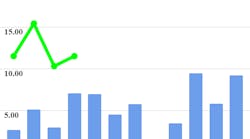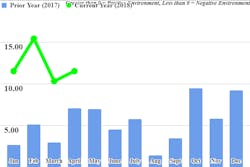A strong freight demand and continued tightness in capacity is reflected in FTR's 11.5 Trucking Condition Index (TCI) for April, which was just released by the analyst on Wednesday morning.
Carriers can expect the favorable conditions to improve further into the third quarter and stay elevated well into 2019, according to FTR analysis.The tight labor market, including a shortage of drivers, is holding carriers back from taking full advantage of the higher rate environment even as it increases their labor costs.
Details of the April TCI are found in the June issue of FTR’s Trucking Update. The ‘Notes by the Dashboard Light’ section in the current issue includes an assessment of the regulatory impacts on the market. Along with the TCI and ‘Notes by the Dashboard Light,’ the Trucking Update includes data and analysis on load volumes, the capacity environment, rates, costs, and the truck driver situation.
“The latest jobs report suggests that carriers' aggressive driver recruiting efforts are paying off but additional growth in freight volumes, continued impact from electronic logging device implementation, and extreme tightness in the overall labor market should keep conditions highly favorable for carriers," said Avery Vise, vice president of trucking research. "The TCI will remain at near record levels until at least the fourth quarter, when the market may begin to stabilize due to additional truck capacity.”
The Trucking Conditions Index tracks the changes representing five major conditions in the U.S. truck market. These conditions are: freight volumes, freight rates, fleet capacity, fuel price, and financing. The individual metrics are combined into a single index that tracks the market conditions that influence fleet behavior.
A positive score represents good, optimistic conditions. Conversely, a negative score represents bad, pessimistic conditions. The index tells you the industry’s health at a glance. In life, running a fever is an indication of a health problem. It may not tell you exactly what’s wrong, but it alerts you to look deeper. Similarly, a reading well below zero on the FTR Trucking Conditions Index warns you of a problem, while readings high above zero spell opportunity. Readings near zero are consistent with a neutral operating environment, and double-digit readings (both up or down) are warning signs for significant operating changes.




